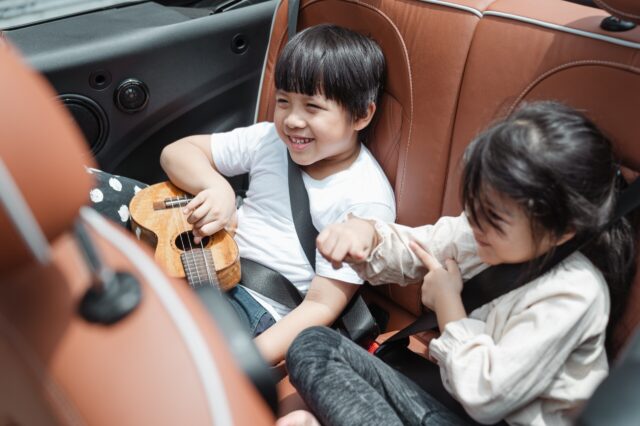Vehicle Heat Safety for Children

Unfortunately, child deaths and heat-related illness, like dying from heatstroke in a hot car, increase during summer.
Since 1998, more than 950 children have died from what is called pediatric vehicular heatstroke, or PVH, and 52 of these hot car deaths occurred since 2022, according to NoHeatStroke.org. Over half of the deaths occurred because an unattended child was forgotten in a motor vehicle. All could have been avoided.
Now, as temperatures continue to soar, it is especially important to highlight the disastrous circumstances that lead to hot car deaths as well as ways to prevent them. Medical experts from UF Health Pediatric Emergency Medicine are here to offer prevention tips and how to help if a child is overheated.
Why children are more at risk
Children are more at risk of overheating because babies, toddlers and any young child who doesn’t have control of their motor functions have no way to access help or water and are unable to exit the vehicle on their own.
Children have a naturally more active metabolism than adults, which produces more overall body heat. Conversely, children perspire less than adults, which makes lowering internal body temperatures more difficult and time-consuming.
Kids absorb more heat than adults because their skin has a larger surface area proportionate to their body compared with adults. Keep in mind that kids may be hot even when adults are not.
Can existing medical conditions increase risk of pediatric vehicular heatstroke?
Yes, certain pediatric conditions prevent the body from cooling properly and will increase the risk of PVH in extreme heat.
Children with attention-deficit/hyperactivity disorder who take stimulant medication will have a higher risk of PVH because the stimulants increase metabolic rates, which increases body heat.
Children who have cystic fibrosis have an increased risk of PVH because the condition prevents the absorption of salt from sweat. A depletion of salt in the body through excessive sweating will lead to increased body temperatures.
Kids with sickle cell disease, or those who carry the trait for it, have an increased risk of PVH due to constriction of blood vessels. Sickle cell patients are more sensitive to changes in the outside temperature.
Obesity also contributes to a child’s inability to cool down and regulate their body temperature. In any of these cases, taking extra precautions may be lifesaving.
What temperature or amount of time is considered dangerous?
The benchmark is to never leave children unattended in a vehicle. No temperature or time limit eliminates the risk of a child dying in a hot car.
Even in an ambient temperature of 75 degrees, a car can exceed 100 degrees in just 30 minutes. In summer, with a temperature of 90 degrees, a car’s internal temperature will be over 100 degrees in just 5 minutes. These statistics stand, regardless of the use of accessories like tinted windows, windshield covers or even parking in shade. In the summer, cars are likely too hot for safety even before we get in them.
If the external environment surrounding a child is warmer than their body temperature, they will not cool down. Cooling of the body slows when humidity levels are greater than 75%. Heat is generated by muscle contractions when kids play, which increases a child’s body temperature. It takes a humidity level of 59% for young children to begin slowly cooling.
Tips for preventing hot car deaths
A parent or guardian’s main objective to avoid overheating, inside or outside a hot vehicle, is to regulate their child’s core body temperature. Keep in mind that if the parent is hot, the kid is hotter. When in extreme heat, remove the child from direct sun and cool them with cold water and air conditioning when possible.
If children have been playing outside when it’s very hot, take extra care to reduce their body temperature before putting them into a hot vehicle. Kids don’t consider when to stop playing themselves, so accompanying adults need to be vigilant to keep them from playing too hard. When observing a young child in hot weather, use fatigue as a sign to insist they take a break. Other signs of overheating are crankiness, stomachache or vomiting.
Consider that a child in a car seat, bassinet or stroller will have limited ventilation from being in a carrier that reduces air circulation. Most baby car seats face backward, which further decreases access to cool air conditioning. Avoid excessively bundling babies in hot weather.
Treatments for minor overheating
For older children, if you detect symptoms of heat exhaustion, immediately begin hydration with cool liquids. Offer an electrolyte solution to drink in addition to water. Use a wet cloth or towel to dampen their head and soak their clothing. For infants, use a cool washcloth to wet their head, under their arms and in their diaper. These solutions work by the use of convection — decreasing body temperature by running cool air or water across the skin — and the use of conduction, transferring heat from the skin to a cool towel.
While these safety tips may help, they are not a guaranteed fix for overheating, especially in extreme heat, such as a hot car. If a child is overheating in a hot car going to the park, running errands or any other outing, immediately stop and go home — no exceptions. If you wait until the situation becomes an emergency, it’s already too late.
What to do in emergency situations
If the situation has progressively gotten worse and a child is overheating, extremely irritable, can’t get comfortable or can’t stay awake, go to the emergency room or dial 911 immediately. Children may not appear sweaty even if they are overheating. If their temperature exceeds 104 degrees, the situation is certainly an emergency. On the way to get professional treatment, use a cold, wet cloth to help cool the child and offer fluids.
Remember, vehicle-related heat illness and death can be avoided if we take the proper precautions and prepare.

